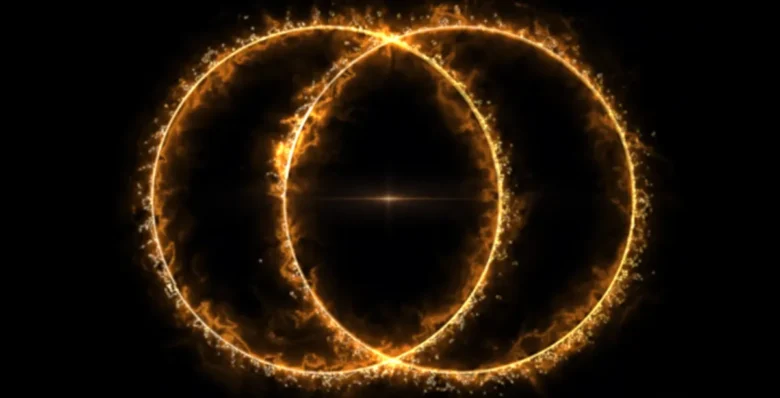| Summary |
|
Astronomers working with citizen scientists in India have discovered three colossal cosmic rings glowing faintly in radio light, among them the most distant and powerful “Odd Radio Circle” ever seen. Using data from the Low Frequency Array (LOFAR) telescope network, the team at the University of Mumbai and the RAD@home Astronomy Collaboratory identified the structures in skies billions of light-years away.
The findings, announced by the Royal Astronomical Society this month, may reveal how galaxies and black holes shaped the young universe and how star systems grew in its violent early years.
The largest of the three, catalogued as RAD J131346.9+500320, sits almost 10 billion light-years away (redshift 0.94) and displays two immense, overlapping radio rings spanning around 800,000 light-years. This makes it both the most remote and the most energetic of its kind ever detected. Researchers say its radio power exceeds that of typical quasars, implying its formation from a galaxy-scale superwind driven by a central black hole.
The twin-ringed pattern suggests a pair of massive outflows rather than a single jet, supporting theories that galactic winds can blow giant plasma bubbles into space. The team believes these loops are relics from repeated jet activity, visible only at LOFAR’s low frequencies of 54–240 MHz.
The second discovery, RAD J122622.6+640622, extends more than 900,000 light-years and lies inside a galaxy cluster. Its southern jet abruptly bends, inflating into a glowing ring, while its northern jet continues straight, likely a result of pressure from the cluster’s hot gas.
Scientists say the distortion shows how million-degree plasma sculpts radio jets over millions of years and traces turbulence inside clusters. The ring’s bright edge is thought to be energized by old plasma flowing back from the jet’s endpoint.
The third case, RAD J142004.0+621715, shows a 440,000-light-year jet unraveling into filaments that form a partial loop. Its host galaxy, an edge-on disk, appears to be shedding gas under ram pressure as it sweeps through its cluster’s environment.
The ring lights up where this outflow collides with older plasma, an event that may have reaccelerated electrons and reignited lost radio emission. Together, these systems show how feedback from jets and winds shapes galaxies and redistributes matter between stars and intergalactic space.
Odd Radio Circles first came to light in 2019 and remain among the rarest known structures in the cosmos. Only a dozen have been confirmed worldwide, each spanning hundreds of thousands of light-years (up to 20 times the diameter of the Milky Way).
Most radiate only at very low frequencies, meaning their electrons are ancient and far from any active galaxy nucleus. Many once seemed to be aftermaths of black hole mergers, but the new findings hint instead at “superwinds” from disk galaxies that repeatedly blow out plasma shells. The revised picture suggests these rings mark where cosmic energy escapes into space and cools over billions of years.
What makes the current study stand out is who found them. The RAD@home Astronomy Collaboratory, based in Navi Mumbai, links hundreds of trained volunteer students, engineers, and amateurs who examine giant radio sky surveys from their home computers.
They compare images from projects like LOFAR’s Two-meter Sky Survey and India’s TGSS to look for structures that automated algorithms miss. While AI tools often overlook unusual shapes, human eyes can detect faint, irregular rings hidden in fuzzy data. Once confirmed, these finds feed back into machine-learning databases to help future telescopes classify complex radio sources faster.
LOFAR, operated mainly from the Netherlands, is the world’s largest low-frequency radio telescope, with stations spread across Europe. Its sensitivity allows scientists to trace weak, ancient emissions that higher-frequency arrays cannot see.
The new research, published in the peer-reviewed Monthly Notices of the Royal Astronomical Society, argues that ORCs serve as “time capsules” of galaxy evolution records of the feedback cycles that switch star formation on and off across billions of years.
Dr. Ananda Hota, who leads RAD@home, says these rings provide rare windows into how black holes and galaxies grow together. The discovery extends ORC observations to nearly half the age of the universe, revealing that such structures have persisted since the era when galaxies first assembled.
Teams from Poland’s National Centre for Nuclear Research and several Indian universities contributed analysis and modeling. More powerful arrays, including the upcoming Square Kilometre Array, are expected to reveal thousands more such rings in the next decade.
Citizen scientists have helped push back the cosmic horizon. By combining global telescope data and human pattern recognition, they have uncovered structures too subtle for computers and too vast for a single observatory. In doing so, they have opened a new chapter in understanding how long-dead galaxy outbursts still echo through space nearly 10 billion years later.
Source: RAD@home discovery of extragalactic radio rings and odd radio circles: clues to their origins

